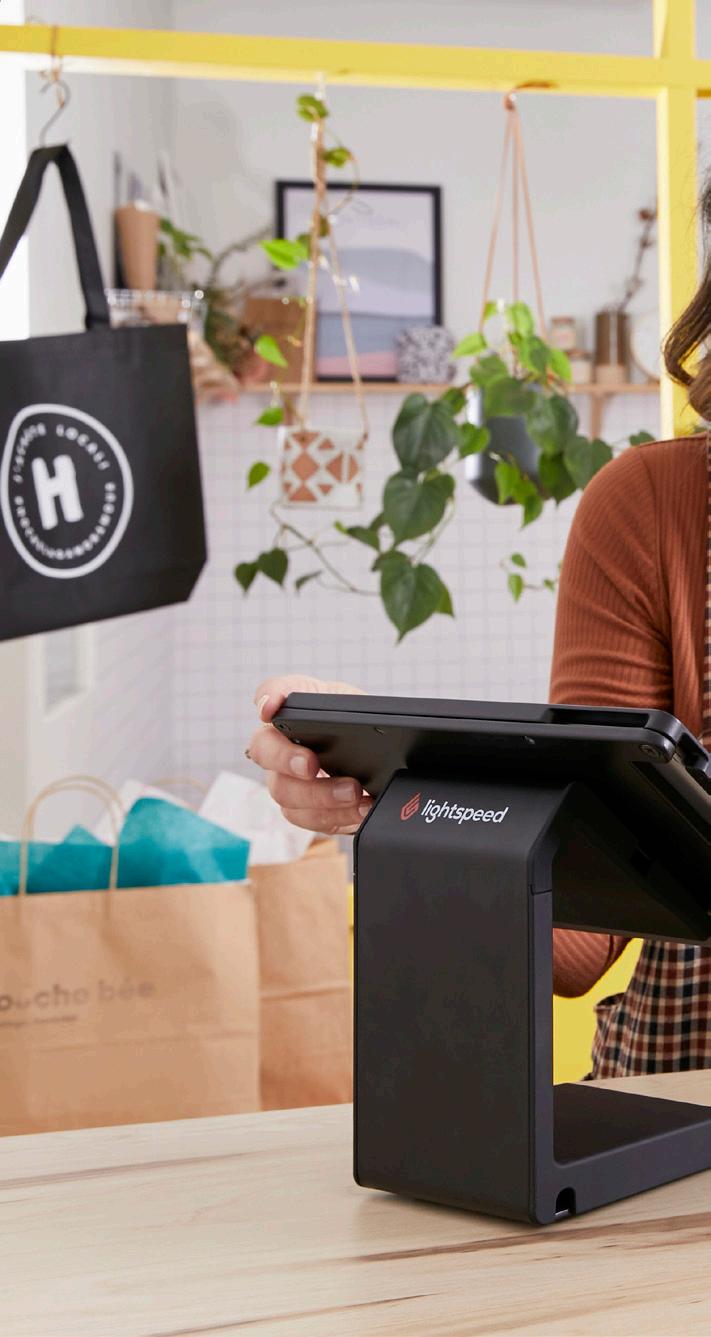
3 minute read
The Power of the Right POS Platform
from Small Business
Swapping out an outdated legacy point-of-sale solution sounds intimidating. But the benefits of a modern, cloud-based unified POS and payments platform can’t be ignored.
The world is enduring a period of economic uncertainty — 85% of U.S. small businesses are concerned about a looming recession, according to the Small Business & Entrepreneurship Council. One source of stress for retailers in this environment is older, legacy point-of-sale (POS) offerings that are increasingly outdated.
“There are a ton of pain points with legacy POS solutions,” noted Ana Wight, general manager of Retail at Lightspeed, a unified POS and payments platform. “You just don’t have the sophistication of tools that really matter now for a small business trying to be successful.” which can have a huge impact on the bottom line, considering retail shrinkage averages about 1.5% of sales.

Modern unified POS and payments offerings like Lightspeed Retail make it easier to have an accurate view of inventory across multiple locations — the warehouse, online, and your social channels. “Before Lightspeed, we would call the shop every 10 or 15 minutes to find out stock levels and sales figures for products,” noted Lightspeed Retail user Yaw Djang, co-founder of homewares retailer Oklahoma. “We’re saving tons of time.”
Djang is not alone — in a recent survey conducted by Lightspeed, 68% of retailers said that adopting new recently added NuORDER by Lightspeed, a leading B2B ordering platform that allows retailers to easily add inventory at the point of sale. This makes the discovery of new brands and suppliers much easier without leaving the unified POS and payments solution.
Modern inventory control
The instinct to avoid a new expense by sticking with an existing, old-school POS solution to avoid short-term upgrade costs is a mistake. A modern unified POS and payments offering can help streamline your business and offer robust inventory tools, technologies, including inventory management tools, had resulted in a positive impact on their businesses.
The extensibility of POS offerings is a key predictor of how well they will adapt to the always-evolving retail market.
For example, Lightspeed
The impact is easy to see. “This tool is absolutely revolutionary, with the ability to import all items from a purchase order into Lightspeed with nothing more than a click of a button,” said Daniel Greenhalgh, president of Skinny Raven Sports. “The import is rich, with pictures and description. The only work that remains is to put it into categories. A massive time saver.”
The extensibility of modern unified POS and payments offerings is only going to become more important over time; retail technology continues to evolve rapidly, and features like autonomous stores, click-andcollect and buy online pickup in store (BOPIS) tools, more selfservice options, and “endless aisle”- type experiences will soon be expected aspects of the shopping experience. A flexible and customizable solution is essential.
Embedded payments and branding
The ability to embed payments into the commerce platform itself is another essential feature of a modern unified POS and payments platform. “When you embed your payments with your commerce platform, you take out a lot of manual steps, a lot of errors,” Wight explained. “There’s that basic, time-saving accuracy, and there’s also a ton more you can do in terms of reporting, insights, and analytics.”
Those capabilities are crucial because connecting with your customers is an increasingly complex challenge. Customers expect a seamless omnichannel experience, and businesses have to find ways to meet their customers where they are: at a physical store, on social media channels, or on an app or website. It’s also an opportunity to drive branding, customer loyalty, and retention.
This is especially important in the modern retail environment where shoppers are aggressively comparing prices across platforms — 45% of consumers have switched to cheaper alternatives, and 44% seek out coupons and promotional codes more often. And retail shoppers will usually only wait about 5-10 minutes before abandoning a purchase, which makes having embedded payments and lightning-fast inventory tools essential.

Making the leap
Wight understands why some business owners still hesitate. “The biggest barrier to change is the fear of change,” she said.
But those legacy POS solutions are increasingly untenable due to expense and the difficulty of using and maintaining them. For example, it takes about 40 hours to learn a legacy POS offering, time that could be better spent actually selling your stock. A more intuitive interface can also make it easier to train even seasonal or temporary workers.
Wight advised that the best thing a business can do when choosing to upgrade its platform is to choose a partner wisely. “It’s hard to make a change and swap out a solution,” she said. “But here at Lightspeed, for example, we’ve really worked hard to make this an easy switch.”
That includes an onboarding team for the initial setup, account managers who guide the business through the process, and access to a 24/7 customer support team.
For her part, Wight is bullish on the future of unified POS and payments platforms like Lightspeed Retail. “Over time,” she predicts, “we’ll see consumers understand there’s a certain type of retailer or restaurant that uses a certain type of point of sale. There will be a sort of halo effect or brand association of like, ‘Oh, I recognize this interaction with the cashier. And I know that I’m in a store that’s gonna offer me a great experience with great products.’”
Written by Jeff Somers




